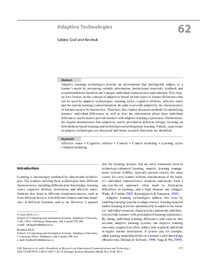Adaptive TechnologiesSabine Graf, Kinshuk
Zu finden in: Handbook of Research on Educational Communications and Technology (Seite 771 bis 779), 2014
|
 |
 Diese Seite wurde seit 3 Jahren inhaltlich nicht mehr aktualisiert.
Unter Umständen ist sie nicht mehr aktuell.
Diese Seite wurde seit 3 Jahren inhaltlich nicht mehr aktualisiert.
Unter Umständen ist sie nicht mehr aktuell.
 Zusammenfassungen
Zusammenfassungen
 Adaptive learning technologies provide an environment that intelligently adjusts to a Âlearner´s needs by presenting suitable information, instructional materials, feedback and recommendations based on one´s unique individual characteristics and situation. This chapter first focuses on the concept of adaptivity based on four types of learner differences that can be used by adaptive technologies: learning styles, cognitive abilities, affective states and the current learning context/situation. In order to provide adaptivity, the characteristics of learners need to be known first. Therefore, this chapter discusses methods for identifying learners´ individual differences as well as how the information about these individual Âdifferences can be used to provide learners with adaptive learning experiences. Furthermore, the chapter demonstrates how adaptivity can be provided in different settings, focusing on both desktop-based learning and mobile/pervasive/ubiquitous learning. Finally, open issues in adaptive technologies are discussed and future research directions are identified.
Adaptive learning technologies provide an environment that intelligently adjusts to a Âlearner´s needs by presenting suitable information, instructional materials, feedback and recommendations based on one´s unique individual characteristics and situation. This chapter first focuses on the concept of adaptivity based on four types of learner differences that can be used by adaptive technologies: learning styles, cognitive abilities, affective states and the current learning context/situation. In order to provide adaptivity, the characteristics of learners need to be known first. Therefore, this chapter discusses methods for identifying learners´ individual differences as well as how the information about these individual Âdifferences can be used to provide learners with adaptive learning experiences. Furthermore, the chapter demonstrates how adaptivity can be provided in different settings, focusing on both desktop-based learning and mobile/pervasive/ubiquitous learning. Finally, open issues in adaptive technologies are discussed and future research directions are identified. Dieses Kapitel erwähnt ...
Dieses Kapitel erwähnt ...
 Begriffe KB IB clear |  machine learning machine learning
|
 Zitationsgraph (Beta-Test mit vis.js)
Zitationsgraph (Beta-Test mit vis.js)
 1 Erwähnungen
1 Erwähnungen 
- Individuelle Förderung und Digitalität (Götz Bieber, Julia Gerick) (2022)


- Individuelle Förderung mit digitalen Medien - Ein Problemaufriss (Heike Schaumburg)


- Individuelle Förderung mit digitalen Medien - Ein Problemaufriss (Heike Schaumburg)
 Anderswo finden
Anderswo finden
 Volltext dieses Dokuments
Volltext dieses Dokuments
 |  Adaptive Technologies: Artikel als Volltext bei Springerlink ( Adaptive Technologies: Artikel als Volltext bei Springerlink ( : :  , 237 kByte; , 237 kByte;  : :  2020-11-28) 2020-11-28) |
 Anderswo suchen
Anderswo suchen 
 Beat und dieses Kapitel
Beat und dieses Kapitel
Beat hat Dieses Kapitel während seiner Zeit am Institut für Medien und Schule (IMS) ins Biblionetz aufgenommen. Beat besitzt kein physisches, aber ein digitales Exemplar. Eine digitale Version ist auf dem Internet verfügbar (s.o.). Aufgrund der wenigen Einträge im Biblionetz scheint er es nicht wirklich gelesen zu haben. Es gibt bisher auch nur wenige Objekte im Biblionetz, die dieses Werk zitieren.










 Biblionetz-History
Biblionetz-History